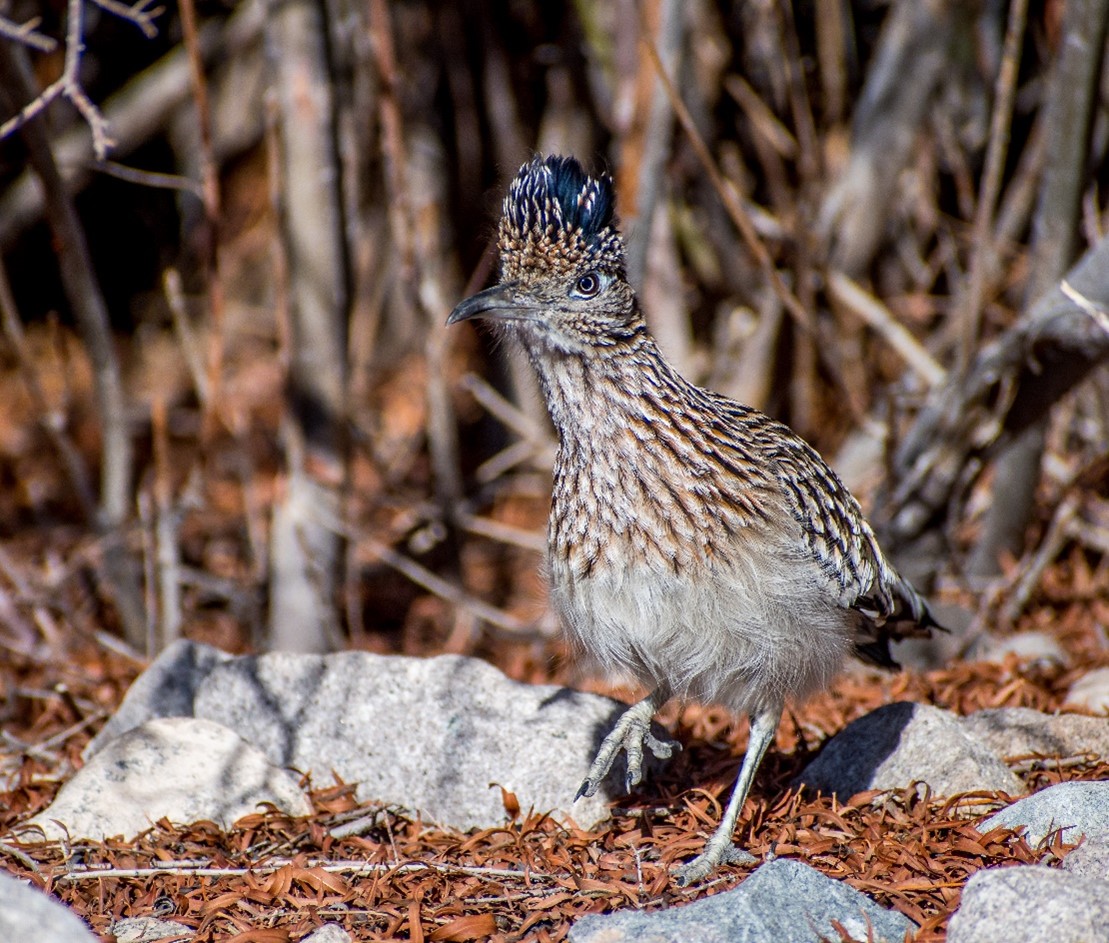The Greater Roadrunner

Wetlands Park? Jurassic Park? No, Really Wetlands Park!
Does this intent look and bipedal stance remind you of anybody? It does me. Don Gibe’s wonderful photo of a greater roadrunner (Geococcyx californianus) at Clark County Wetlands Park forcefully reminds me of the Velociraptor dinosaur made so famous (or infamous) by the movie Jurassic Park. Roadrunners do look very prehistoric—maybe because, as paleontologist Kristy Curry Rogers says in her “Great Courses” lecture series, Rediscovering the Age of Dinosaurs, “birds ARE dinosaurs!”
Really? They are! Paleontologists have been debating the link between birds and dinosaurs since finding the first Archaeopteryx, a feathered, winged dinosaur with a toothed skull and long tail, over a hundred years ago. Now enough fossils showing evidence of the bird/dino relationship have been found to end the debate. Birds are the descendants of theropod dinosaurs, a very diverse group of carnivorous, bipedal walking, often beautifully feathered dinosaurs with grasping hands and a variety of specializations for feeding.
Birds share many traits with dinosaurs from the theropod group, including their signature feathers. Feathers evolved in a group of theropods called coelurosaurs that famously includes Tyrannosaurus rex. By the way, T. rex fossils have also been found to contain amino acids consistent with those of modern chickens! Theropod dinosaurs and birds share similarities in their skeletons, too. Birds have a specialized wrist bone called a “lunate carpal,” and fused collarbones (called “furculae”, best known to us as “wishbones”). These bones also show up in some fossil theropods. The beaks, claw sheaths, and feathers of modern birds contain the unique protein Beta keratin. So does the 66-million-year-old fossilized, sickle-shaped toe claw sheath of a theropod found in Madagascar.
Evidence also shows that dinosaurs were “birdlike” in their behavior. Fossilized dinosaurs at first thought to be raiding the nests of other dinosaurs for eggs have turned out to be careful parents, sitting protectively on their own nests. An immature dinosaur from China was fossilized (possibly while asleep) sitting with its hind legs folded beneath its body, its tail wrapped around it, and its head tucked back under a forelimb, looked for all the world like a sleeping modern bird!
So, watch for the prehistoric looking greater roadrunner along the Park trails. The bird is easy to identify, with its long legs, long tail, blue-and-red streak behind each eye, and bushy crest. You can even identify it by the tracks it leaves behind, with two toes facing forward and two backward, making the letter “x”. This modern day “Velociraptor” is often seen on the hunt, and since it is not a choosy eater, its “Park cafeteria” (well stocked with insects, scorpions, spiders, centipedes, lizards, snakes, other birds, small mammals, fruit, and even seeds) is likely to be open most of the time.
Speaking of the cafeteria… have you ever wondered if T. rex would taste like chicken? Curry Rogers says “No, chicken tastes like T. rex”!
– By Chris Leavitt, President; photo by Don Gibe.
Please enjoy these YouTube videos!
Roadrunner Bird Facts That Goes Beep Beep
Roadrunner Race Against Time
Greater Roadrunner Bird-Communication, Calls
